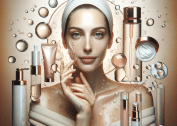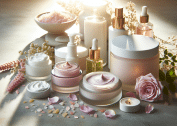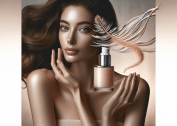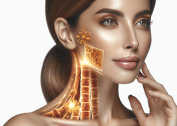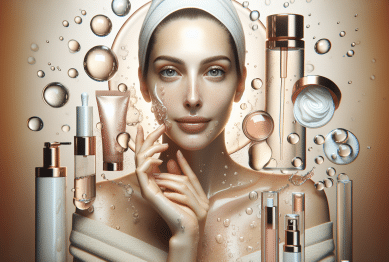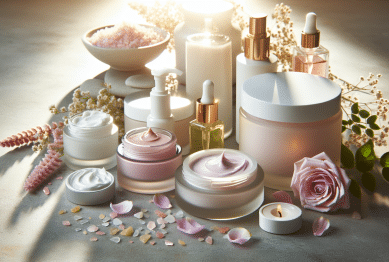Unlock new insights on achieving glowing skin through science-backed wellness habits, innovative skincare routines, and nutrition tips you can rely on. This guide reveals what dermatologists and beauty experts want everyone to understand about sustainable radiance.
Understanding the Foundations of Glowing Skin
Many people are fascinated by the idea of radiant, glowing skin. It’s often seen as a reflection of wellness, but the process goes deeper than just surface-level treatments. Healthy, luminous skin typically results from a combination of cellular renewal, hydration, and a balanced skin barrier. Proper skin function involves protection against environmental stressors while maintaining optimal moisture. Dermatologists highlight that skin’s glow is an indicator of both inner and outer health. Dullness, in contrast, can signal dehydration or barrier disruption. Building a foundation for radiance requires learning how to support these mechanisms—starting from the basics of gentle cleansing and adequate moisture, progressing to targeted treatments.
Genetics play a role, but daily choices impact skin’s health more than most realize. Nutrition, sleep patterns, and sun protection are critical elements that influence skin vibrancy. Antioxidant-rich diets and adequate hydration work on the inside, fueling the skin’s natural repair cycles. Protective habits, like daily use of broad-spectrum sunscreen, safeguard collagen and elastin from environmental harm. Over time, layering such habits helps sustain healthy texture and tone, reducing issues like hyperpigmentation or premature aging. The message from experts is clear: consistent self-care routines yield more lasting glow than quick fixes appearing promising on social media.
Emotional well-being also shapes the appearance of the skin. Chronic stress can lead to hormonal shifts that trigger oil imbalances, inflammation, or flare-ups of conditions like eczema. Mindfulness techniques, adequate sleep, and relaxation exercises have been shown to lessen stress-induced skin disruptions. In recent research, the skin-mind connection has gained attention for its role in preserving both skin appearance and comfort. Embracing a holistic view—where mental health and wellness practices are as important as topical regimens—creates a path to more resilient, glowing skin in everyday life.
Skincare Routines for Everyday Radiance
Crafting an effective skincare routine can feel intricate, but a few core steps form the backbone of daily skin radiance. Gentle cleansing is crucial—removing debris, pollution, and excess oils without stripping helpful natural oils. Hydration comes next, with lightweight serums and moisturizers designed to lock in water and support the skin’s barrier. Ingredient selection matters, so look for formulas that include ceramides, hyaluronic acid, niacinamide, or vitamin C. These powerhouses help boost radiance, even texture, and defend against free radical damage. Personalizing your routine according to season, skin type, or activity makes a significant difference, as products perform best when tailored to unique daily needs.
Morning routines should always include sunscreen. The cumulative effect of UV exposure can undermine even the most diligent skincare efforts, contributing to brown spots, fine lines, and loss of firmness. Physical (mineral) sunscreens with zinc oxide or titanium dioxide provide broad protection. Layering sun protection with antioxidants further enhances defense from pollutants and blue light. In the evening, focus on repair and regeneration. Retinoids and gentle exfoliants can expedite cell turnover, revealing fresher layers of skin. Before experimenting, it’s wise to introduce new actives slowly and observe how skin reacts. This deliberate approach nurtures stronger, brighter skin without irritation.
Weekly rituals—like hydrating masks, steam facials, or gentle exfoliation—offer an extra boost for luminous skin. However, more is not always better. Over-exfoliation can compromise the barrier, leading to sensitivity or breakouts. Experts often recommend sticking to evidence-based products and avoiding trends that lack scientific support. Simplicity, consistency, and patience remain the most reliable strategies for achieving and maintaining a true glow. Seek support from board-certified dermatologists if persistent skin issues, such as severe acne or sudden texture changes, appear. Their guidance tailors skincare plans for long-term success and comfort.
The Influence of Nutrition on Skin Health
Nutrition and glowing skin are closely linked. What’s eaten impacts skin resilience, healing, and luminosity. Diets rich in antioxidants—such as vitamins A, C, E, and polyphenols—can slow environmental damage and aid repair. Fatty acids from sources like salmon, walnuts, or flaxseed can reinforce the skin barrier, lessen redness, and enhance hydration. Poor nutrition can show up as dullness, increased breakouts, or delayed healing, reminding that skin often mirrors the body’s internal health.
Hydration is another major factor. Skin, like any organ, depends on enough water to stay plump and elastic. While no magic number fits everyone, aiming for regular intake of water-rich foods—fruits, vegetables, teas—supports daily needs. Limiting highly processed foods, sugar, and excessive caffeine helps reduce the risk of inflammation. The connection between gut health and skin clarity is gaining ground in new studies, with probiotic-rich foods (like yogurt, kimchi, or sauerkraut) being shown to promote more balanced, calm skin.
It’s easy to overlook micronutrients, yet substances like zinc and selenium play vital, restorative roles. Zinc influences wound healing and can moderate oil production. Selenium acts as a shield against oxidative stress and environmental aggressors. Consulting with a registered dietitian can help identify nutritional gaps that might affect the skin. Ultimately, building a balanced plate brimming with variety gives the skin the raw materials it needs for day-to-day brilliance and long-term health.
Modern Beauty Tools and Technologies to Consider
In recent years, technology has transformed the way individuals approach skincare. Non-invasive devices, like LED light therapy masks and microcurrent tools, have surged in popularity due to their promise of safe, at-home skin improvement. LED therapy can target acne and stimulate collagen production, while microcurrent tools aim to tone facial muscles. Scientific studies point to their potential, but emphasize consistency and correct usage for visible benefits. For many, these technologies become a complement to—not a replacement for—core skincare routines.
Professional treatments at medical spas and dermatologist offices—like chemical peels, laser resurfacing, or microneedling—are gaining traction for those seeking targeted results. Chemical peels can enhance cell turnover, ease pigmentation, and smooth fine lines. Laser treatments address discoloration, texture, or broken capillaries through focused energy. Microneedling harnesses the skin’s natural ability to regenerate by creating micro-injuries, which in turn stimulate collagen and elastin. Not every option suits every skin type, so initial consultations help set realistic expectations and prevent adverse outcomes.
Even traditional tools—like jade rollers, gua sha, or facial cups—are making a comeback as part of self-care rituals. While they don’t replace clinical results, these tools may aid lymphatic drainage or boost circulation with regular use. The key lies in gentle techniques and pairing massage with high-quality serums for glide. No matter the technology, professional guidance remains essential for avoiding misuse and maximizing results. Knowledge about which approach fits specific skin needs ensures safety and satisfaction on the journey to luminous skin.
Lifestyle Choices That Amplify Natural Glow
Lifestyle decisions have a profound effect on skin’s vibrancy. Prioritizing sleep is vital, as nighttime repair is when the skin renews and rehydrates. Sleep deprivation can quickly lead to a lackluster complexion, puffiness, and more pronounced fine lines. Creating a bedtime routine—dim lighting, screen limits, soothing rituals—helps signal to the body that it’s time to enter restorative sleep, which the skin directly benefits from in texture and tone.
Movement is another often overlooked beauty tool. Regular physical activity boosts circulation, bringing more oxygen and nutrients to skin cells. It also helps balance hormones and reduce inflammation, factors tied to blemishes and dullness. Outdoor activities carry extra benefits—provided sunscreen is worn—because fresh air and natural light can elevate mood as well as skin vitality. Conversely, smoking has well-documented negative effects, reducing oxygen supply and accelerating visible signs of aging.
Mindfulness and stress management techniques like yoga, meditation, or journaling can contribute to overall wellness and by extension, skin appearance. Chronic stress releases hormones that not only affect long-term health, but can also disrupt collagen production and hydration. Studies show that managing stress can help prevent inflammatory reactions on the skin. Together, balanced daily habits form a cumulative pathway toward a natural, lasting glow that topical products alone cannot deliver.
Common Misconceptions About Glowing Skin
Many myths persist in the realm of skincare, often fueled by social media or clever marketing. One frequent misconception is that expensive products or a lengthy routine always produce better results. In truth, basic, well-chosen products often outperform fads. The skin thrives on a balanced blend of cleansing, hydration, and protection—not on complex, overcrowded regimens filled with trending ingredients. Quality should always trump quantity.
Another misconception: natural means safer or more effective. While plant-based products can be beneficial, some botanicals may irritate sensitive skin or lack sufficient clinical evidence. Patch testing is crucial when adding new items, and relying on dermatologist recommendations helps cut through hype. Similarly, skipping sunscreen on cloudy days or for certain skin tones is risky. UV damage is cumulative and indiscriminate, so daily protection is always necessary for a healthy, glowing complexion.
Lastly, it’s common to underestimate the impact of general health on skincare outcomes. Adequate water intake, sleep, stress management, and nutrition are sometimes dismissed in favor of topical solutions. Yet, scientific research consistently shows that the best glow comes from within—a reflection of both lifestyle and skin-friendly choices. Integrating these realities dispels confusion and supports realistic, sustainable skin goals for everyone.
References
1. American Academy of Dermatology Association. (n.d.). Skin care and lifestyle tips for healthy skin. Retrieved from https://www.aad.org/public/everyday-care/skin-care-basics/care/healthy-skin
2. Harvard Health Publishing. (n.d.). Nutrition and skin health. Retrieved from https://www.health.harvard.edu/staying-healthy/nutrition-and-skin-health
3. Mayo Clinic. (n.d.). Healthy habits for glowing skin. Retrieved from https://www.mayoclinic.org/healthy-lifestyle/adult-health/in-depth/skin-care/art-20048237
4. Johns Hopkins Medicine. (n.d.). The science behind beautiful skin. Retrieved from https://www.hopkinsmedicine.org/health/wellness-and-prevention/the-science-behind-beautiful-skin
5. National Institutes of Health. (n.d.). Stress effects on the skin. Retrieved from https://www.ncbi.nlm.nih.gov/pmc/articles/PMC4082169/
6. Cleveland Clinic. (n.d.). The gut-skin connection. Retrieved from https://health.clevelandclinic.org/the-gut-skin-connection-how-food-affects-your-face/



